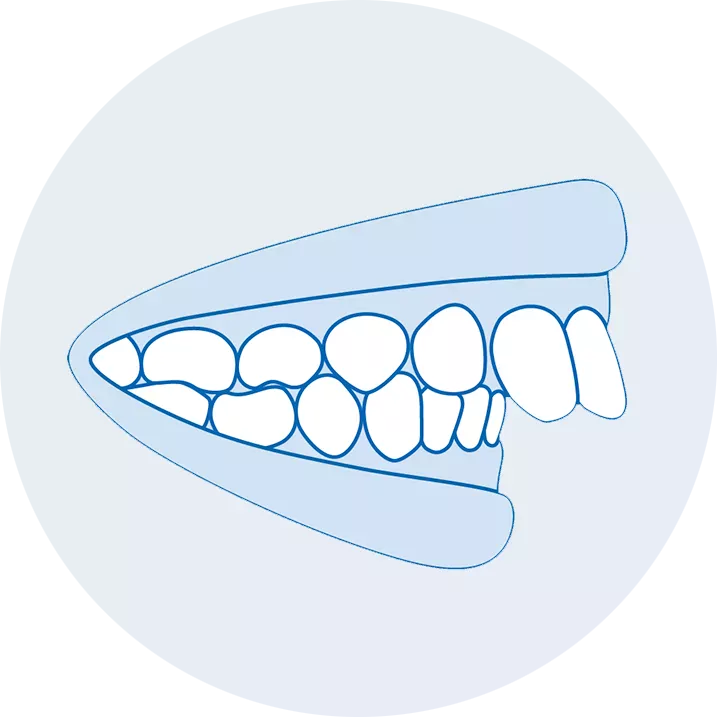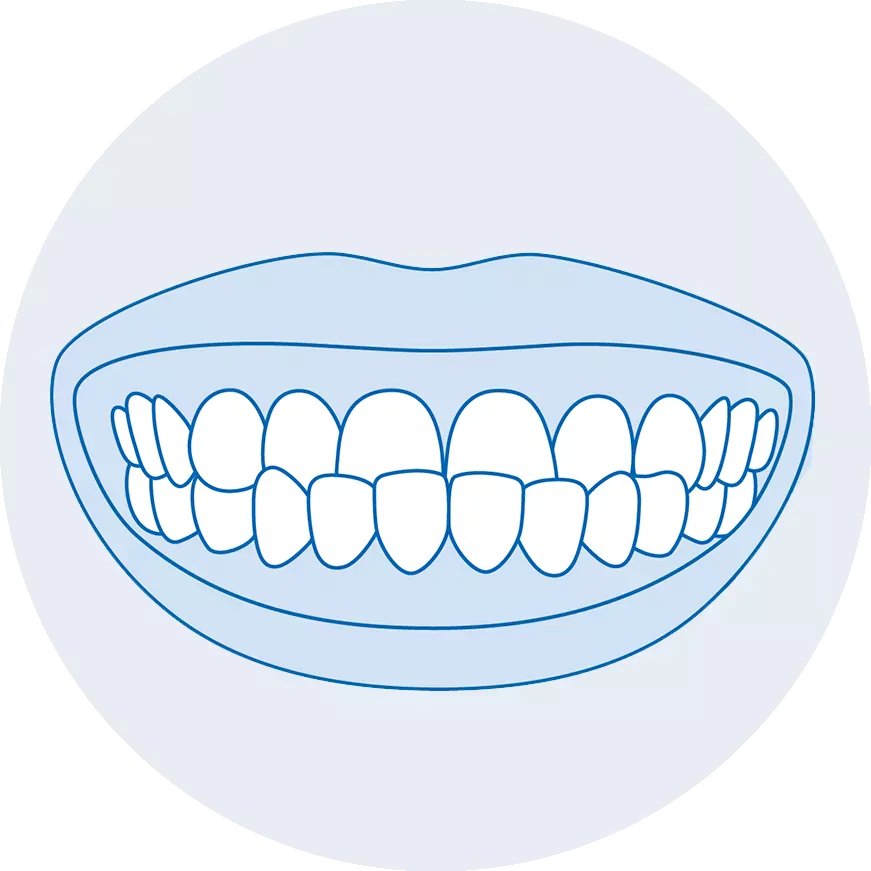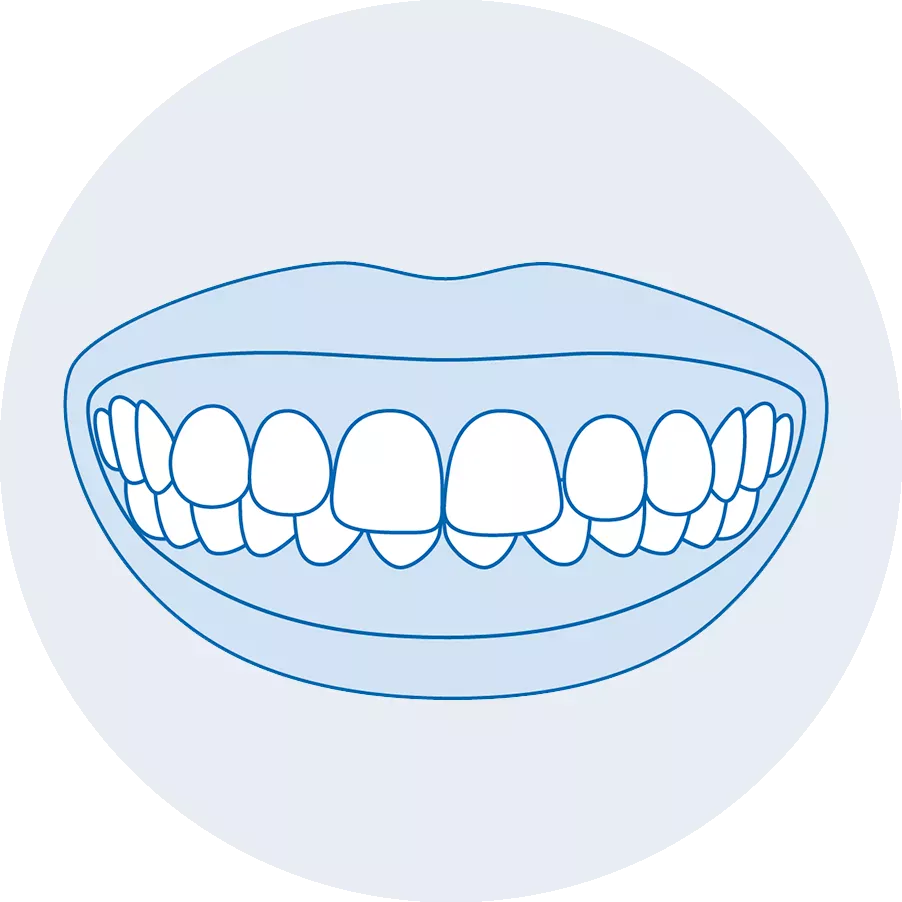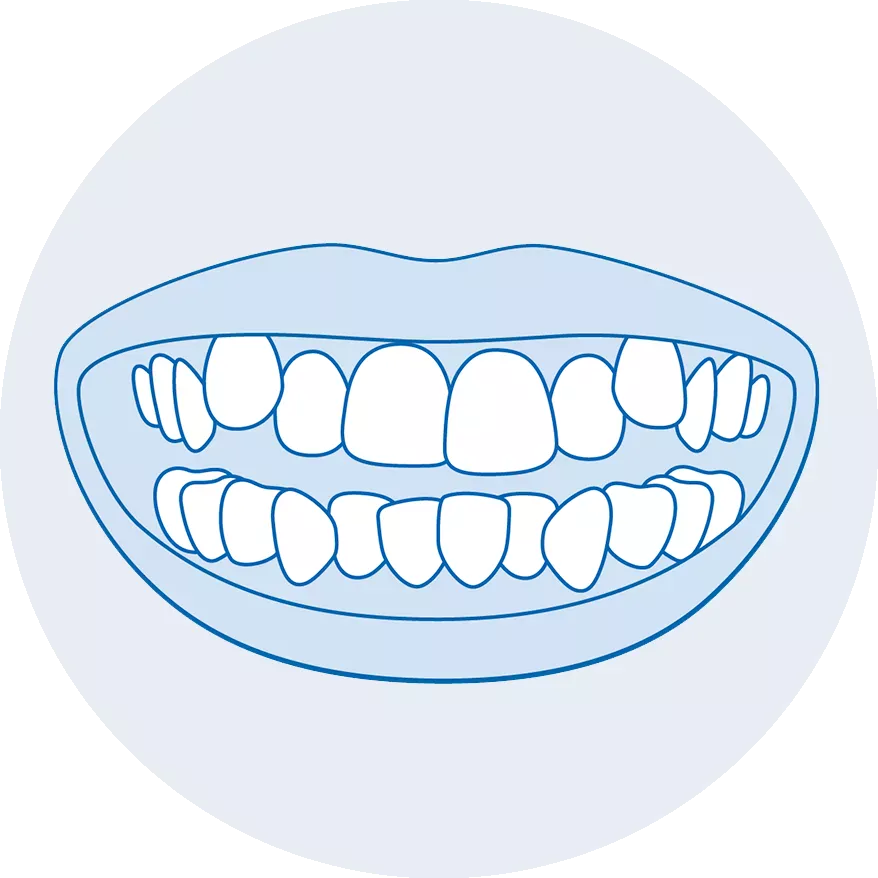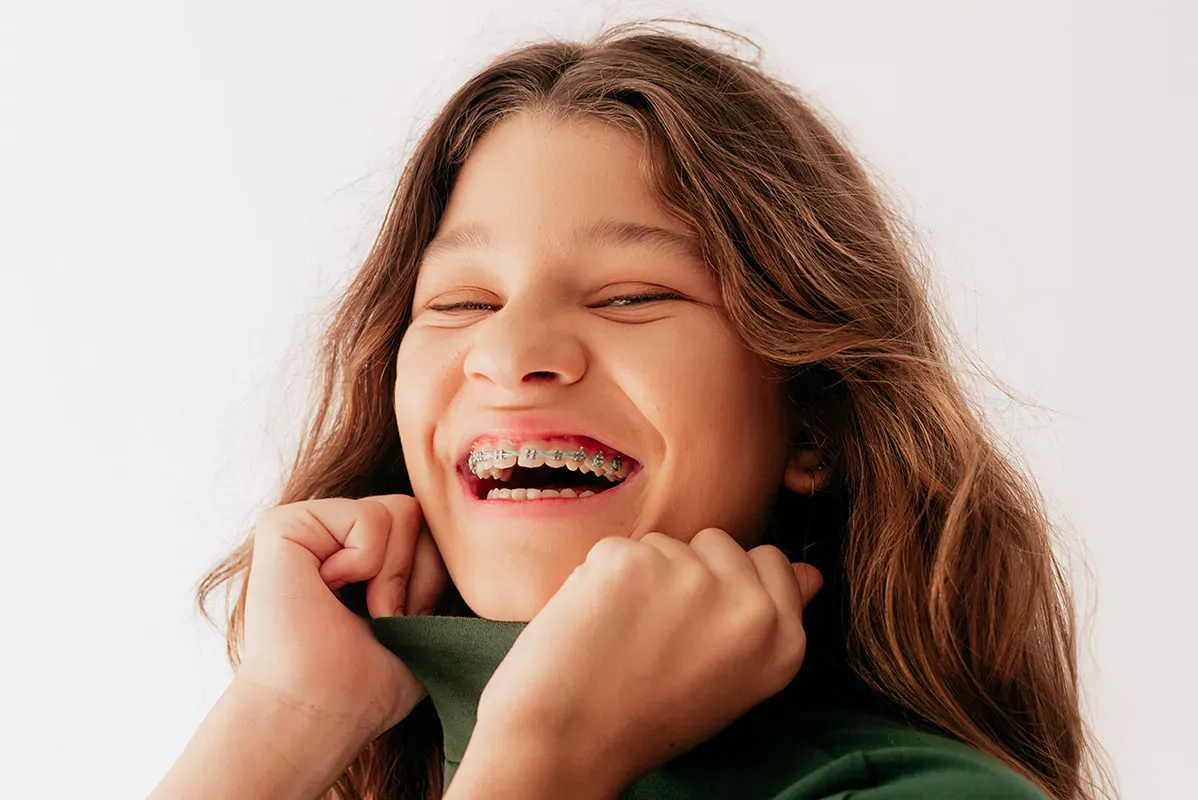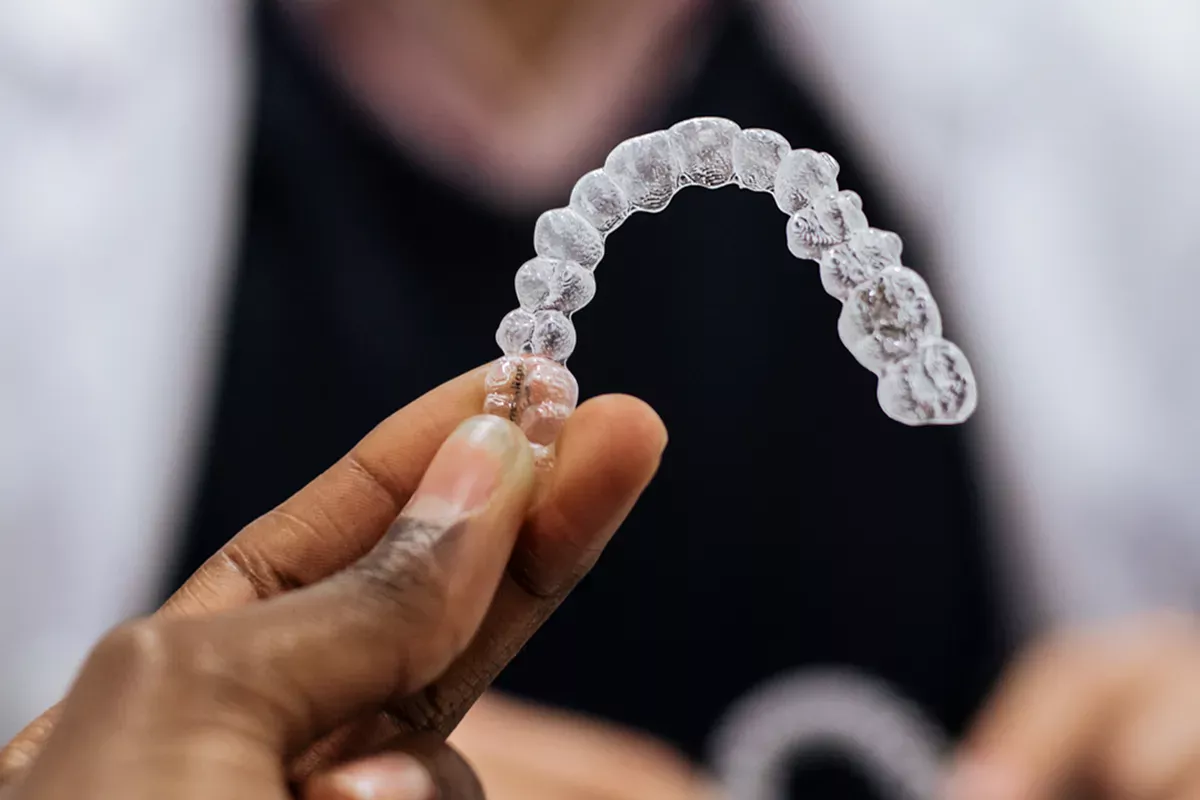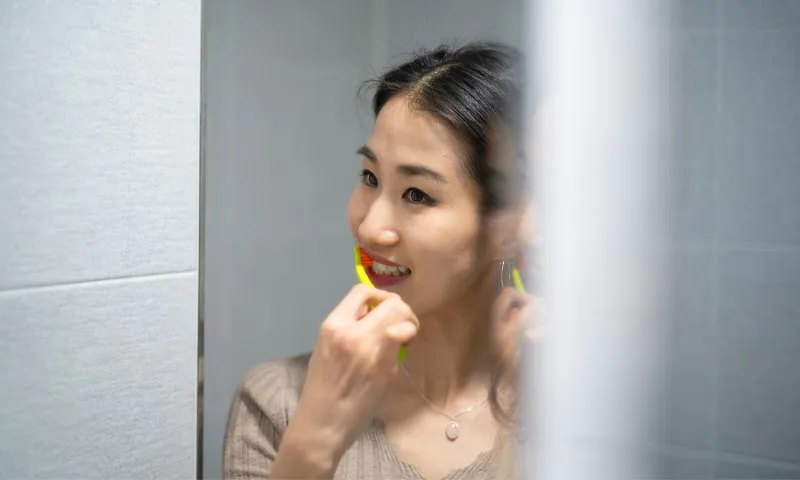What types of malocclusions are there?
There are a myriad of variations to crooked teeth. Sometimes the problem occurs with the anterior teeth, sometimes with the posterior ones. Find an overview of common malocclusions here.
Overjet
This type of malocclusion is commonly referred to as "buck teeth". The most striking feature is the excessively protruding upper incisors. A lower jaw that is either too small or set too far back may be the reason for this. Similarly, an overjet can also occur when the upper jaw is too big or when the lower incisors are tilted inwards.
An overjet can prevent proper biting and make it difficult to close the lips completely. Additionally, it may result in overloading of the teeth and the periodontium. Moreover, there is a higher risk of injury to the protruding teeth, particularly if you have an accident. In extreme cases, the lower jaw may not grow in proportion to the child's face.
Prognathism (underbite)
In contrast to an overjet, prognathism causes the lower jaw to protrude. With this condition, the lower anterior teeth are positioned in front of the upper ones. This type of misalignment can result in restricted biting and chewing ability. The anterior teeth have to cope with excessive loads, and the entire periodontium is also put under too much strain. A characteristic feature of prognathism is often a prominent chin, colloquially referred to as the 'Habsburg chin' or 'Habsburg jaw'. When an undersized upper jaw is the cause of the malocclusion, it can lead to stunted development of the entire midface.
Open bite
With an open bite, the upper and lower teeth fail to make contact at both the front and back of the mouth. It results in a space between the anterior and the posterior teeth; a "gap" through which the tongue can be inserted, even though the teeth should be fully closed.
This kind of misalignment can be caused by a poorly functioning tongue or abnormal swallowing patterns. Babies and children who suck their thumbs or use an incorrect soother are particularly at risk. Many conventional soothers are not ergonomically designed to respond to the needs of a developing jaw. The weight of the muscles in the mouth is disturbed and may result in underdevelopment of the jaw and considerable misalignment of the teeth, including an open bite.
Possible symptoms of an open bite include problems with correct biting positions and overloading of the teeth and periodontium. Furthermore, an open bite can impede proper pronunciation and lead to speech impediments, such as a lisp.
Good to know:
With normal dental alignment, the upper incisors typically overlap the lower incisors in the lower jaw by approximately two to three millimetres.
Deep bite
A deep bite refers to malocclusions where the upper teeth protrude more than three millimetres beyond the lower teeth. This type of malocclusion can cause the upper and lower teeth to no longer support each other.
Cover bite
A cover bite is a pronounced form of the deep bite. With this type of misalignment, the upper incisors are notably tilted inwards over the lower incisors. As a result, the lower anterior teeth are completely concealed by the upper ones and no longer visible. This can pose a risk of the biting edges of the upper teeth coming into contact with the lower gums – or vice versa. It could also cause the lower anterior teeth to bite into the palate.
Cross bite
With a cross bite, the upper posterior teeth bite too far inwards towards the tongue. Usually, the cause is a dental arch that is too wide. The condition could also result from the chewing surfaces of the upper posterior teeth failing to make contact with their 'counterparts' in the lower jaw and thus overlapping them.
Spacing
Spacing, as the name suggests, is all about noticeable gaps or spaces between the teeth. In the case of a wide jaw, this can occur especially in the front section of the mouth. A noticeable gap between the central upper incisors is a common characteristic of this condition. And this gap even has its own name: Diastema mediale. If such spacing is extremely pronounced and cannot be rectified through orthodontic treatment, replacing missing teeth with dental prosthesis devices may be an option. In certain instances, a low-set lip frenulum may also contribute to excessive spacing. Surgical repositioning of the lip frenulum may offer a suitable solution in such situations.
Narrow jaw
Individuals with a narrow jaw are at risk of encountering irregular teeth spacing. If this is the case, the adult teeth may erupt too late or may also be closely spaced. Crowding increases the risk of dental decay since the contact points between the teeth are hard to access for proper cleaning. Those affected often experience various aesthetic concerns as well.
Lack of space in the posterior teeth
As with the narrow jaw, insufficient space in the posterior region often leads to crowding. Teeth can also erupt outside the dental arch, or a person may suffer delayed eruption of multiple teeth. Once again, those affected are often concerned about their appearance. Moreover, restricted chewing ability may be demonstrated and there is a risk of dental decay where narrow contact points prevent correct cleaning.
Displaced and retained teeth
Displaced or retained teeth describes the condition where teeth fail to erupt properly and remain inside the jaw. Commonly affected teeth include the wisdom teeth, as well as the upper canines and the upper and lower premolars. The underlying cause of this issue is usually a lack of space or abnormal positioning of the tooth bud. When teeth are in their proper position but fail to emerge, they can negatively impact adjacent structures. In such cases, it is often necessary to surgically expose the tooth bud. This is often followed by orthodontic treatment.
Cleft lip and palate
Cleft lip and palate is one of the most common birth defects and occurs in about one in every 5,000 babies. In Europe, one in every 500 children is born with a cleft lip and palate. The cleft can cause misalignment of the teeth. Affected children often also suffer non-formation of the adult teeth, i.e. they simply do not exist.
Typically, oral surgeons collaborate with various other specialists to ensure cleft lip and palate is treated before the child begins school. While necessary, such operations can potentially impact teeth alignment. For instance, scar tissue tension can have adverse effects. The upper jaw might not develop normally, leading to insufficient space for the teeth. Scarring and muscle imbalances can also result in misalignment of the teeth in the future. These impairments often lead to pronunciation disorders in many children.
Crooked teeth: Causes and risk factors
The causes behind malocclusions are as diverse as the types of malocclusions themselves. Crooked or wonky teeth can be hereditary in some cases, while in others, hormonal issues may be a contributing factor. In numerous cases, however, crooked teeth may result from comfort-seeking behaviours like thumb sucking. Below you will find some key causes along with explanations of the risk factors associated with crooked teeth.
Heredity
Certain types of crooked teeth can indeed be inherited. This applies, for example, to conditions like prognathism, where the lower jaw protrudes, causing the lower anterior teeth to extend beyond the upper ones.
Thumb sucking or the wrong soother
Thumb sucking is a common comfort-seeking behaviour, especially among infants and young children. Some babies tend to put their biggest finger in their mouths while still in the womb. And it is also normal for them to use their thumbs after birth. However, this habit can cause crooked teeth in the long run. A typical example is the "open bite", where a gap remains between the upper and lower teeth even when sufferers attempt to bite their teeth together. Unfortunately, frequent use of many conventional soothers can lead to the same problem. This is because most models have round or cherry-shaped mouthpieces that are too large, exerting unfavourable pressure on the still-soft upper jaw. As a result, the upper jaw yields, deforms and ultimately becomes narrower than the lower jaw. Later, orthodontic corrections are often necessary to achieve normal teeth alignment, thereby allowing the child to chew, swallow, breathe and speak correctly.
Good to know:
Misalignment of the milk teeth can affect the permanent dentition. Parents should therefore closely monitor the progression of their child's teeth. Proper dental care, starting from the first milk tooth, is also essential. Our baby toothbrush has been specially developed for small and sensitive mouths. The fine filaments and soft rubberised brush head are gentle on both the teeth and the gums.
Wisdom teeth under suspicion
In many individuals, wisdom teeth often only emerge during young adulthood. There is a theory that these four additional teeth can lead to overcrowding in the jaw, potentially causing displacement of the other teeth. However, there is no scientific evidence confirming that wisdom teeth cause crooked teeth. Some studies have, nevertheless, explored this potential link.
Gaps
If, for example, a tooth has had to be extracted and the resulting gap is not closed with an appropriate dental prosthesis device, such as a crown, the adjacent teeth may shift.
Malnutrition
Chronic vitamin deficiency can disrupt the process of bone formation. This disruption can lead to the development of misaligned teeth. So, always ensure both you and your children maintain a balanced diet.
Early milk tooth loss
If milk teeth fall out too early, they can no longer serve their role as placeholders. As a result, adjacent teeth might grow into the gap, potentially displacing the adult tooth that should have naturally filled the space.
Crooked teeth: Who may be affected?
Malocclusion can affect any age group. This is because our teeth are continually shifting and moving throughout our lives. After all, they have to withstand various pressures and loads every day. Even following orthodontic treatment there is no guarantee that the teeth will maintain their new position indefinitely.
We have summarised the potential problems related to misaligned teeth that may arise at different stages of life.
Babies and young children
The first milk tooth usually comes through when a child is around six months old. This first tooth and other milk teeth may then already be crooked because malocclusion can begin to develop even before the milk teeth erupt. This could be attributed to genetic factors. However, this is only the underlying cause in about 20 per cent of cases. The most common reasons are bad habits. In babies, as already mentioned, thumb sucking or excessive use of soothers can, in particular, play a role in this regard.
The best approach is to consult with your dentist to determine the factors contributing to your baby's crooked milk tooth. Not all cases of teeth misalignment necessarily require treatment. However, treatment is often needed when problems with chewing and swallowing arise.
Good to know:
The Curaprox baby soother size 0 helps ensure that your baby's jaw and teeth remain unharmed while they suck on it. It actively prevents misaligned teeth, encourages proper mouth breathing and supports the healthy development of jaw growth.
Crooked teeth in young children
Soothers and thumbs are significant risk factors for the misalignment of teeth in toddlers, similar to their impact on babies. Excessive sucking on either a soother or a thumb can potentially result in jaw deformation. The most effective approach is, naturally, to discourage children from developing these comfort-seeking habits in the first place. In the following paragraph, you will discover some tips to help achieve this goal.
And even if you are unable to completely eliminate your child's thumb-sucking habit or use of a soother, there is no need to panic. Since immediate action is not always required, even if the milk teeth come through misaligned. It is, however, important to visit a dentist or orthodontist regularly to have teeth development monitored professionally. If in doubt, removable braces or an aligner may be considered as an option down the line. These orthodontic devices often achieve good results correcting minor forms of misalignment. For more severe and persistent malocclusions, teenagers may have to wear fixed braces, for example.
Putting an end to thumb sucking – with these helpful tips
As previously mentioned, the most effective way to prevent crooked teeth is to discourage thumb sucking in babies and toddlers. Easier said than done – we know. However, the following tips may help you wean your child off thumb sucking:
Try to use positive examples and work together as a team
Everybody knows: If something is forbidden, it is all the more exciting. So, rather than abruptly removing the soother from young children or yanking the thumb out of their mouths, try to involve them in a collaborative effort to work on the habit. Team up with your child and transform the process into a playful game. According to the motto: Yes, we can do this together! Start by setting small, yet achievable, goals. For instance, telling your child not to put their thumb in their mouth all day is usually an unrealistic and overwhelming task for them. Maybe your child has not sucked on their thumb for half an hour. Great! Now is the moment for praise – and plenty of it!
Offer an alternative
Thumb sucking provides comfort to many children. They do it subconsciously in order to overcome and process insecurities and stimuli. If we take away this coping mechanism, it can leave a big void. Maybe there is an alternative. Try offering your toddler a nice comforting blanket or a cuddly toy. Here, too, you can boost the team effort by selecting the blanket or toy together.
Use ointments
Breaking the thumb-sucking habit in children, especially when they are stubborn thumb suckers, can be a challenging and daunting task. Sometimes, an ointment from a pharmacy that is applied to the thumbnail can be helpful. The taste is typically not appealing, which can result in the thumb no longer being placed in the mouth. Just ask your pharmacist for advice.
Offer distractions and read books on the subject
Thumb sucking can also indicate that your child is bored. Hence, try to pay close attention to when your child puts their thumb in their mouth. In such situations, you can readily intervene to divert your child's attention, perhaps through a game or a song. With slightly older toddlers, you can also address the thumb-sucking habit as a meaningful subject of discussion. There are great books on this topic that you can read to your child. Children often discover a role model in these books, someone with whom they can practise quitting thumb sucking together.
Good to know:
It is widely understood that thumb sucking and using the wrong soother can result in crooked teeth. Less commonly known is, however, the fact that nail biting also poses a risk. It is, therefore, important to help young children break this habit, even though it can often be challenging. Seek guidance and advice from your paediatrician or dentist if you have a highly determined and stubborn nail biter at home.
Teenagers
As you have already read, crooked teeth are not uncommon in young children. However, if the misalignments are left untreated or treatment is initially not recommended, the crooked teeth can be "carried over" into adolescence. That said, there is also the possibility of tooth alignment improving naturally as your child matures. This occurs because the jawbone continues to develop, allowing the teeth to potentially realign themselves. If the misalignment remains though, fixed or removable braces are typically employed. Such orthodontic treatment usually begins when the child is between nine and eleven years old. This timing is chosen to make the most use of the growth phase. During this period, a relatively small amount of force is generally sufficient to tackle tooth corrections. This minimises damage to the teeth and the periodontium. Consequently, treatment typically lasts several years.
Which method of tooth correction is suitable – for example, fixed or removable braces – depends on the root cause of the crooked teeth and the degree of misalignment.
Adults
Since our teeth continue to move and shift throughout our lives, it is possible for them to undergo changes in adulthood, even if you received orthodontic treatment when you were a teenager. The anterior teeth in the lower jaw are frequently impacted, resulting in misalignment. This occurs because our posterior teeth naturally tend to shift towards the centre.
Good to know:
Do you have crowded or overlapping front teeth? Then you should pay particular attention to dental care in these areas. To effectively clean the hard-to-reach spaces between teeth, we recommend using our interdental brushes, which are available in a variety of sizes. And DF 850 dental floss is ideal for especially tight interdental spaces.
But there are also other factors that can lead to the development of misaligned teeth in adulthood. We have summarised some common reasons for you below:
Grinding teeth
If you grind your teeth at night, substantial pressure is exerted on both the teeth and the entire periodontium. This can lead to your teeth shifting.
Read more: What to do about teeth grinding?
Tooth loss
Unfortunately, there may come a time when we have to bid farewell to a tooth during our lifetime, resulting in a gap between our teeth. In this case, it is important to fill this gap with a suitable replacement. Failure to do so may pose a risk of neighbouring teeth shifting or tilting into the empty space. The result: Crooked teeth.
Gum diseases
Diseases such as periodontitis, a bacterial inflammation of the dental bed, cause the bone and gums to recede. The lack of attachment to the bone can lead to teeth shifting or tilting.
Read more: How to combat bleeding gums
Accidents
An accident-causing injury to a person's mouth or teeth can also cause the teeth to become loose. In such instances, a dentist may determine it necessary to use tooth splints for correcting their position. So, if you have been involved in an accident and are worried about the condition of your teeth, it is advisable to make an appointment with your dentist as soon as possible.
Older people
The reasons just mentioned can cause teeth to shift, subsequently resulting in misalignment within the oral cavity. And this holds true for every age. This is why older people can suffer from misaligned teeth, too – also from an aesthetic perspective. But, nowadays, nobody has to put up with this, particularly when difficulties with swallowing or chewing arise. If you are thinking about aligning your teeth in your later years, consult an orthodontist to determine the appropriateness of the treatment and which method would be the most suitable. In fact, a transparent, removable brace may be enough to straighten your crooked teeth.
How do I get straight teeth?
What can you do about crooked teeth? Regrettably, there is no one-size-fits-all treatment for achieving perfectly aligned teeth. The available options encompass fixed braces, removable braces and even the placement of implants, especially when a gap between the teeth is the underlying issue.
Only your orthodontist can decide which treatment is best for you. It is absolutely essential for a dentist to conduct a thorough examination of your individual dental history and to prepare an appropriate treatment plan based on this evaluation.
Nonetheless, we will provide you with some general answers to questions regarding potential treatment methods for misaligned teeth here.
Not a good idea: Aligning teeth yourself
The quest for beautifully aligned teeth often attracts numerous dubious providers with enticing promises of achieving this goal with minimal effort and without breaking the bank. For instance, there is an abundance of online offerings for removable braces that you can order directly through the Internet, and some even allow you to create your own dental impressions at home. And all of this comes in an attractive and "affordable" instalment payment package.
We strongly advise you not to be lured by such bargains. The task of straightening teeth should be left to experienced orthodontists who can assess your teeth in person.
Hard to believe but true: If you want, you can find lots of instructions on the Internet on how to supposedly self-align your teeth. Videos depict young people wrapping rubber bands, threads or other objects around their teeth to reposition them. The main reason behind these DIY methods is quite simple: the costs. Again, we advise you very strongly against using any of these methods. Attempting to self-align your teeth will not lead to successful results and could potentially compromise your oral health. The following section provides all the essential information you need to get a rough estimate of the expenses associated with professional treatment.
Why is it dangerous to straighten teeth yourself? Rubber bands, threads or similar aids can exert incorrect and potentially harmful pressure if not correctly and professionally applied. This can be painful and cause teeth discolouration. Since the affected tooth may not be adequately supplied with the necessary nutrients. Furthermore, the roots of the teeth may also lose their firm hold, causing them to become loose.
Please do not be duped by all the before and after images on show. Quite often, these images are not authentic and portray an entirely misleading impression. If you are unhappy with your teeth, your initial point of contact should always be an orthodontist.
Who pays for braces for children and adults?
Straightening crooked teeth is a time-consuming and expensive endeavour. For severe cases, the costs can even total CHF 15,000. Typically, you can expect minor corrections to cost between CHF 4,000 and CHF 5,000.
Basic health insurance usually covers dental treatment resulting from severe conditions of the chewing system or serious general illnesses. A severe jaw anomaly could be one such condition.
In most cases, however, the costs for realigning teeth using removable braces and brackets are not covered, not even for children. Many Swiss health insurance companies therefore offer supplementary dental insurance that involves cost-sharing for dental corrections. It is thus absolutely crucial to consult your health insurance company regarding potential subsidies before going ahead with treatment. Jumping the gun and having orthodontic treatment done without any approval from your insurance is not advisable.
If you want to get supplementary dental insurance before undergoing orthodontic treatment, we recommend comparing offers from multiple health insurance companies to secure a favourable deal.
Crowns instead of braces – is that possible?
In certain cases, crowning a misaligned tooth can indeed be considered a suitable alternative. This is usually an option if the crooked tooth or adjacent teeth are damaged and dental treatment would be necessary anyway. But again: It is up to your orthodontist to make this decision. They will advise you in detail about the various options available.
Can adult teeth be aligned without fixed braces?
In adulthood, many individuals do not want to wear fixed braces – possibly over an extended period of time. They often prefer discreet models that are minimally invasive. But do they exist? The answer is: Yes. Let us show and explain some of the possibilities to you below:
Transparent aligners
Aligners are transparent, custom-fitted splints designed to adjust your teeth. Just like a gum shield, you place them over your teeth, and that is where they do their job: They gently guide the teeth in the correct direction. Transparent aligners are generally less suitable for children as their teeth are still growing. For adults, however, aligners are often a great alternative to fixed braces.
Important to know: Aligners are often a viable option when misalignment of the teeth is only mildly pronounced.
Good to know:
When using aligners, it is also important to maintain excellent oral hygiene, as the teeth are susceptible to potential risks associated with wearing them. To mitigate this risk, you can use an aligner foam: The foam can help restore the tooth enamel and protect your teeth from potential dental decay. We recommend using it three times a day. To do so, spray the aligner foam onto your aligner before inserting it into your mouth.
An appropriate cleaning agent is recommended for additional care of the aligner. A few drops are already enough. Simply apply the liquid to the inside of the aligner and then clean it, preferably with a CS smart toothbrush. Its extra-small brush head effectively reaches every nook and cranny of your aligner.
Lingual braces
Lingual braces are basically fixed braces but are attached to the inside surface of your teeth. However, they employ exactly the same principle as fixed braces: Wires and brackets are used to move the teeth in the correct direction. These lingual braces are typically much more expensive than traditional brackets. Furthermore, individuals who wear lingual braces often report discomfort and lengthy adjustment periods.
Retainers
Retainers are suitable for all age groups. However, you should know that retainers are often only used after teeth have been aligned with the aid of traditional braces or aligners. Retainers then act as stabilisers to keep the teeth in their corrected positions. Nevertheless, they can also be used to correct minor misalignments. Fixed or removable retainers are available. The fixed ones are bonded to the teeth from the rear.
Veneers
Veneers are porcelain shells that an orthodontist bonds to the front surface of your teeth. Important to know: Usually, some of your tooth enamel needs to be removed for this procedure. Veneers may be a suitable option for individuals with gaps between their teeth, discoloured teeth or damaged teeth. Please note, however, that they are only suitable for adults, as they need to be custom-made to fit precisely. The teeth must be fully developed for this task. Further, this form of tooth alignment is usually an expensive undertaking.
Veneers: Everything you need to know
Surgery
Unfortunately, all types of braces have their limits. Especially when it involves not just isolated misalignment of the teeth but also misalignment of the jaws in relation to each other. In such cases, surgery becomes a viable option. Oral and maxillofacial surgeons can, for instance, perform procedures to surgically align the upper and/or lower jaw by repositioning the jaws. Typically, orthodontic treatment takes place in parallel, as jaw misalignments usually go hand in hand with misaligned teeth.
Compared to braces, surgery is, of course, a more drastic intervention. Therefore, always seek professional advice and preferably request information from more than one health care professional.
Palatal expansion
Palatal expansion – as the name suggests – expands the palate to create more space for both the upper and the lower teeth. From the outside, this orthodontic procedure is hardly noticeable: An expander is attached to the teeth using bands. The screw in the middle of the expander can be adjusted with a small key to gradually widen the jaw.
The method is usually suitable for children and youngsters under the age of 15. At these young ages, the upper jawbones are still pliable. It is best to consult your orthodontist to determine the suitability of these expanders for adults. But be careful: Request detailed information about any potential discomfort or pain associated with this procedure. Palatal expansion has a reputation for causing significant discomfort.
Beauty is relative and subjective
If you are considering straightening your crooked teeth solely for aesthetic reasons, you may want to take a moment and look at Japan first. In Japan, crooked teeth are regarded as the epitome of beauty, especially for women – a trend that has persisted for over a decade.
The "yaeba look", or "double-tooth look", is especially popular, with the upper canines pushed slightly forward and the adjacent incisors pushed inward. This trend is intended to evoke associations ranging from a fang-like appearance to a childlike look. Since such a symmetrical misalignment of the teeth rarely occurs naturally, it is increasingly common for dentists to intervene, marking a concerning trend.
But even if Japanese women only have "normal" crooked teeth, it makes them attractive in the eyes of Japanese men because this small flaw symbolises approachability and shows that the other person is not perfect. And that is not such a bad way of looking at things – after all, we all have our flaws and imperfections, whether in our face or elsewhere.
Anyhow: Tolerating imperfection is not entirely alien to us in our part of the world either – despite the influence of Hollywood and Instagram. Just think of Brigitte Bardot, who has perhaps the most famous tooth gap of all time; a beauty mark now being given a new lease of life by Mick Jagger's model daughter Georgia May. And many male celebrities have also made it to the top with crooked or gapped teeth, such as the singer Seal, the footballer Ronaldo (R9) and the actor Willem Dafoe. In the end, it is the other things in life that matter more.
Sources:
Considine, Austin: A Little Imperfection for That Smile?, at: nytimes.com.
Deutsches Ärzteblatt: Daumenlutschen und Nägelkauen schützen vor Allergien.
Deutsche Gesellschaft für Kosmetische Zahnmedizin e.V.: Japan: Schiefe Zähne als Schönheitsideal.
Deutscher Verlag für Gesundheitsinformation GmbH at www.leading-medicine-guide.com: Zahnfehlstellungen: Informationen & Zahnspezialisten.
Dentolo: Schiefe Zähne: Wie sie entstehen & wieder gerade werden.
Gesellschaft für Zahngesundheit, Funktion und Ästhetik:Deckbiss: Zwanghafter Biss verursacht Gesundheitsprobleme/ Weisheitszähne: Zusammenhang mit CMD.
Initiative ProDente:Eltern können schiefe Zähne vermeiden.
German National Association of Statutory Health Insurance Physicians: Häufige Fehlstellungen / Weisheitszähne / Die kieferorthopädische Behandlung.
Kassenzahnärztliche Vereinigung Nordrhein: Zahnfehlstellungen / Zahnfehlstellungen– Frühbehandlung
Kieferorthopäde089: Tiefbiss & Deckbiss: Ursachen, Auswirkungen und Behandlung bei Kindern & Erwachsenen / Schiefe Zähne.
Kieferorthopädie Berlin, Dr. Voslamber: Zusammenhang zwischen Körperhaltung, Mundatmung und Kieferfehlstellungen.
Lux, Sebastian: Daumenlutscher haben seltener Allergien, at: link.springer.com.
Mgo Fachverlage GmbH & Co. KG: So schadet Daumenlutschen den Zähnen, at: dental-team.de.
Moneyland.ch: Krankenkassen: Zahnbehandlungen bei Kindern.
National Library of Medicine: Zahnentwicklung und Zahndurchbruch.
Plück, Sarah: Wie dem Kind das Daumenlutschen abgewöhnen?, at: familie.de.
Nelson, Sara: Yaeba: Japanese 'Double Tooth' Trend Will Give You A Costly Crooked Smile, at: huffingtonpost.co.uk.
Universitätsklinikum Regensburg: Kieferorthopädie im Kinder- und Jugendalter.
Universitäts Spital Zürich: Kieferfehlstellungen und Zahnfehlstellungen / Kieferorthopädische Chirurgie bei Zahnfehlstellungen und Kieferfehlstellungen.
Uniklinik Freiburg: Schnuller: Eine Gefahr für den Kinderkiefer.
All websites last accessed on 9 May 2023.
 Swiss premium oral care
Swiss premium oral care

